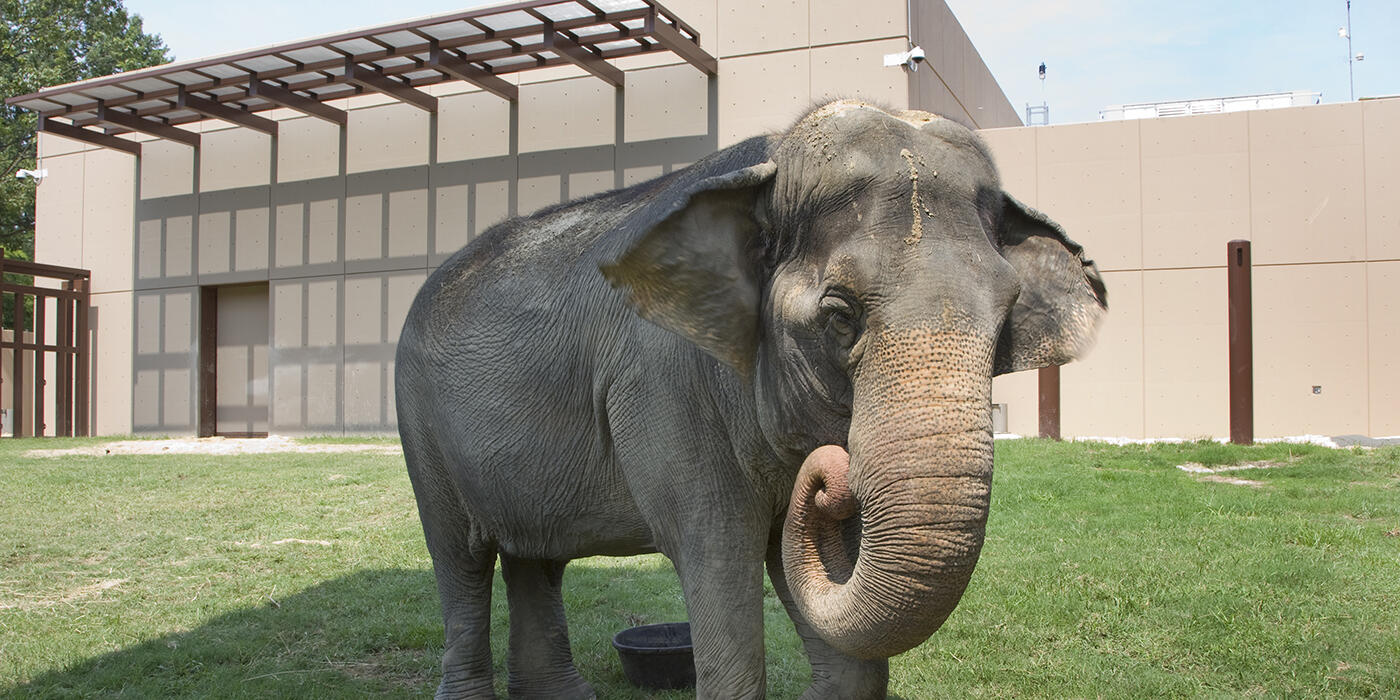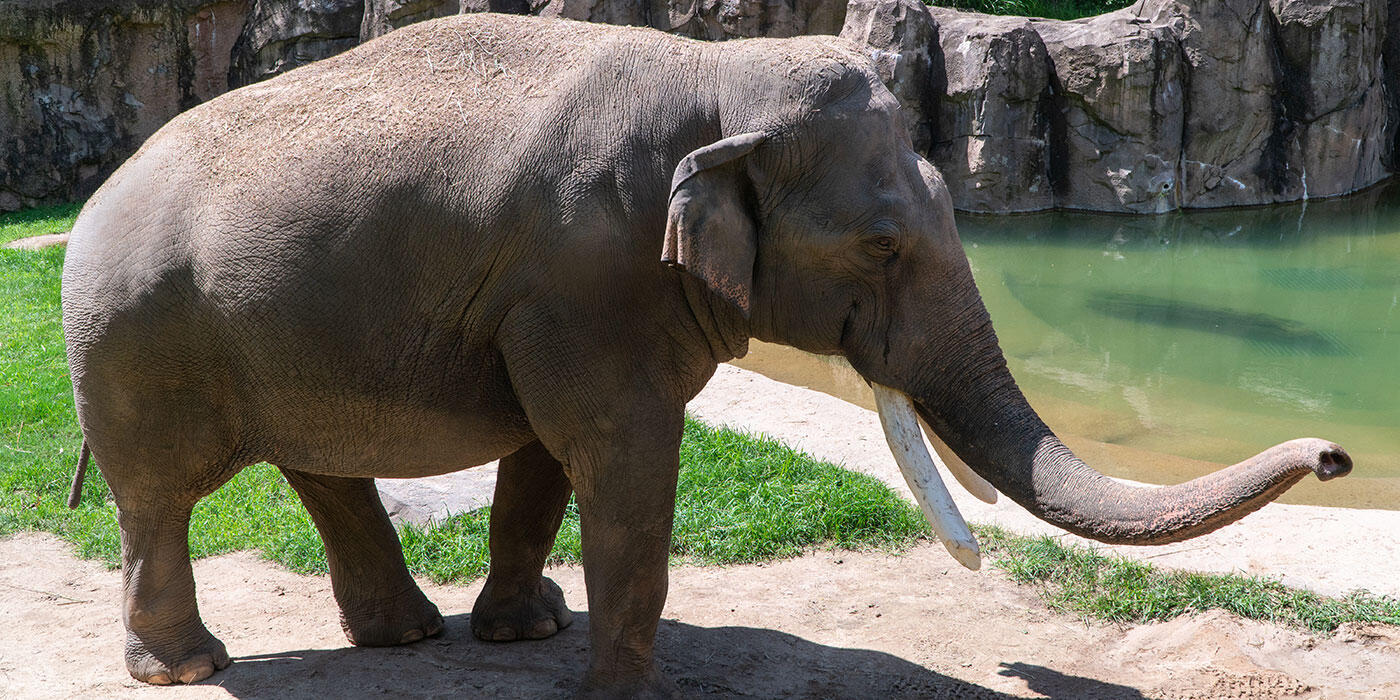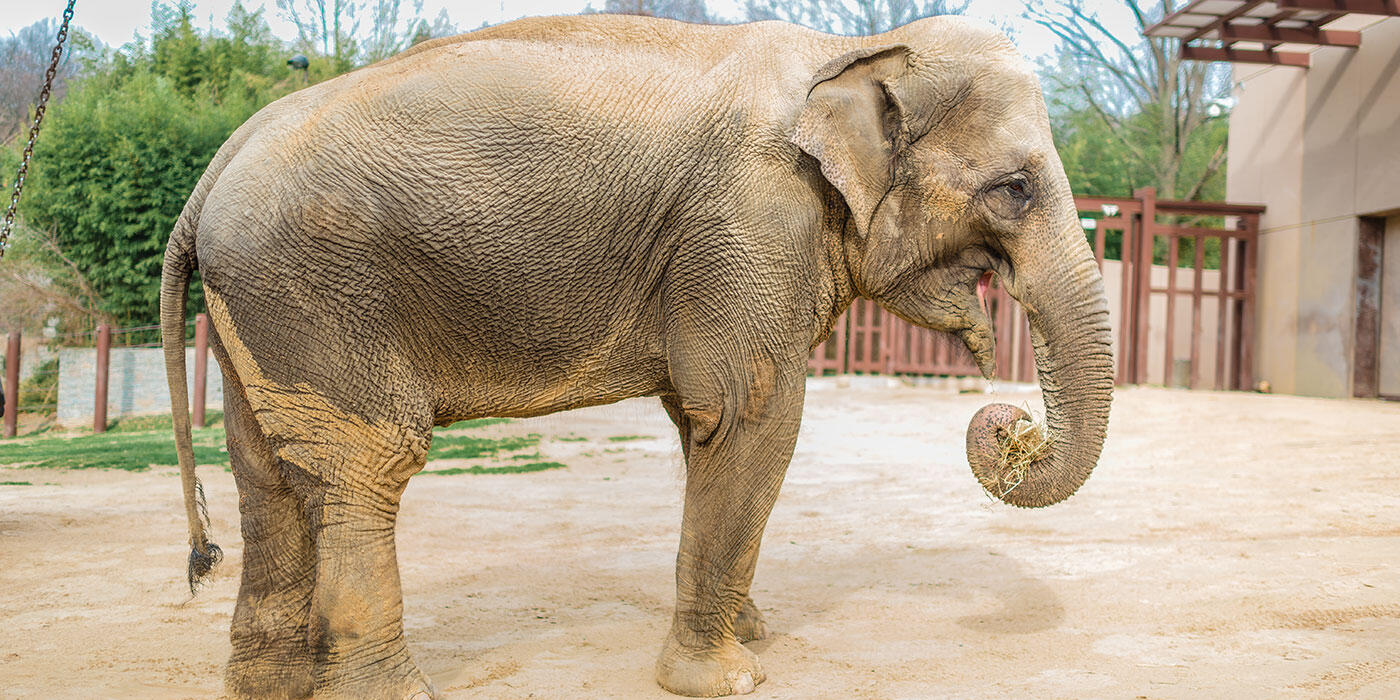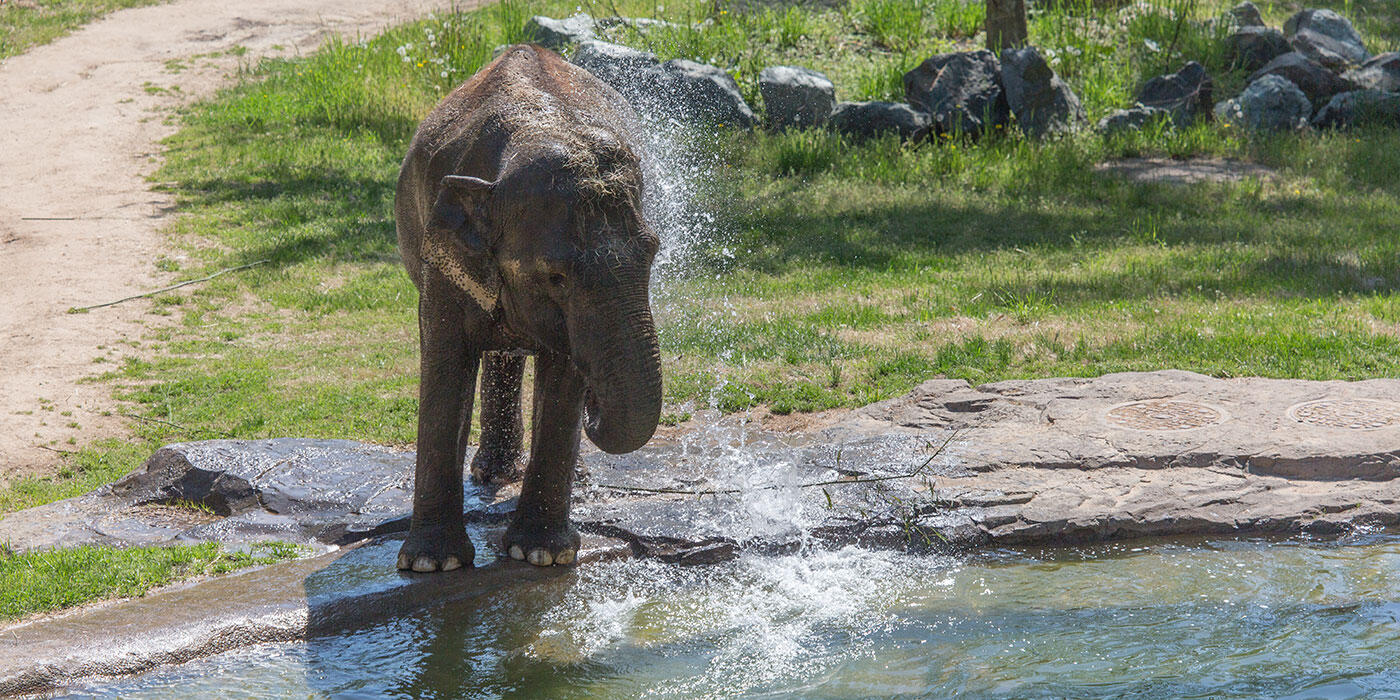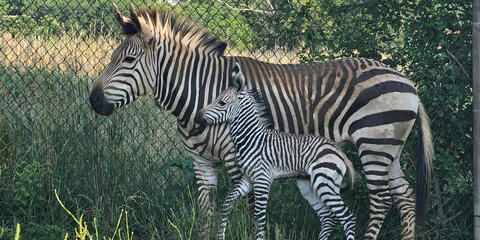Physical Description
Asian elephant skin is gray, but parts sometimes lack color, especially on and around the ears, forehead and trunk. This de-pigmentation is believed to be controlled by genetics, nutrition and habitat, and generally develops as an elephant ages. Brownish to reddish hair covers the bodies of young elephants. The amount of hair reduces with age, and the color darkens.
Elephant skin varies from paper thin in some places, such as on the inside of the ears, to as thick as 1 inch (2.54 centimeters) in other places, such as around the back. Despite its thickness, the skin is sensitive due to a rich nerve supply. Elephants protect their skin from the sun and bugs by regularly covering themselves with dirt, sand and mud. Their large ears function as cooling devices. The ears contain many blood vessels. As an elephant flaps its ears on hot days, the blood in these veins cools, which then cools the elephant's brain and travels back through the body, reducing body temperature by several degrees.
An elephant's brain is large, weighing between 9 and 13 pounds (4 and 6 kilograms). Elephants are thought to be highly intelligent animals, and they have a great capacity to learn. In fact, much of their behavior is learned behavior rather than instinctive behavior.
Unlike other mammals, where the legs are in an angular position, the elephant's legs are stacked in an almost vertical position under the body. This positioning, along with the detailed anatomy of their long bones, provides a strong support for the animal's great weight. The vertical position of the limbs allows the elephant to remain standing for long periods without expending much energy. It also allows elephants to sleep while standing, as well as while lying down.
In most mammals, the bones contain a narrow cavity. In elephants, this cavity is lacking. Instead, a network of dense perforated bone occupies the space, which makes the bones stronger and able to withstand more pressure. The elephant's skeleton is designed for mobility as well as strength. An elephant must have physical structures and coordinated muscular and neurological systems to accomplish survival skills, such as standing on their rear legs and climbing up and down steep slopes.
Elephants actually walk on their toes and have a thick, fibrous pad on the bottom of each foot. This pad acts as a shock absorber, protecting the leg and toe bones from jarring under its weight and cushioning each step.
The trunk is a fusion of the nose and upper lip. It contains no bones, but is composed of muscles, blood and lymph vessels, nerves, little fat, connective tissues, skin, hair and bristles. Cartilage is found only at the base of the trunk, dividing the nostrils. The trunk has about 150,000 muscle units and tendons that provide the elephant precision, as well as strength of movement. These often tiny muscle units tend to be arranged radially or longitudinally and, by acting against one another, allow the trunk to be moved in any direction. Although delicate in its movements, the trunk is also a very powerful organ that can lift heavy objects with ease.
Asian elephants have one small projection at the end of their trunk, called a "finger," which aids with precision. Elephants use their trunks to take up water and squirt it into their mouths. The trunk is capable of performing many other functions as well, including feeding, snorkeling, dusting, smelling, sifting, sorting, touching, sound production and communication, lifting, pushing, defense and offense. It can hold about 2 gallons (7.57 liters) of water. Senses of smell and touch are very important for elephants. Their trunks help them "know" their world.
Asian elephants have six sets of teeth, all six of which are present in the skull at birth. They are, however, very small. Each successive set of teeth is larger, more complex and lasts longer than the previous set. As a result, an elephant's skull grows throughout its lifetime to accommodate the new and ever-larger teeth. The teeth are replaced in a horizontal progression, similar to that of a conveyor belt. The worn teeth move forward, break and fall out of the mouth or are swallowed. An elephant's age can be estimated by examining molar sequence and wear.
Tusks are modified upper incisors that grow throughout an individual's life at a rate of several inches per year. They are composed of ivory, a material similar to bone that is made primarily of calcium and phosphate. The tusk has a pulp cavity containing nerve tissues. In an adult animal, about two-thirds of the tusk is visible while the remaining one-third is embedded in the socket, or sulcus, in the cranium.
Newly developing tusks have a conical cap of smooth enamel that eventually wears off. Not all elephants develop visible tusks; in the Asian species, only some males have large, prominent tusks. Most female and some male Asian elephants have small tusks, called tushes, which seldom protrude more than an inch or two from the lip line. Tushes have a slightly different composition than tusks. They are small and brittle, causing them to easily break. A significant number of adult male Asian elephants are tuskless. The percentage of males with tusks varies by region, with less than 10 percent in Sri Lanka to approximately 90 percent in India. This disparity may be a reflection of the intensity of past ivory hunting.
In the African elephant species, generally, but not always, both the males and females have tusks. Tusks are extremely useful, multipurpose instruments. Elephants use them to dig for water, salt, minerals and roots; to debark trees; as levers to manipulate objects in their environment; for rescuing calves; for threat displays; as weapons for defense and offense; as trunk rests; and as protection for the trunk.
Size
Elephants are the largest living land animal. Slightly smaller than their African cousins, adult Asian elephants weigh on average between 6,000 and 12,000 pounds (2,750 and 5,420 kilograms). They typically stand 6 to 12 feet (1.8 to 3.8 meters) tall at the shoulder. Males are usually larger than females.
Native Habitat
Asian elephants are found in isolated pockets of India and Southeast Asia, including Sumatra and Borneo. They were formerly widely distributed south of the Himalayas, throughout Southeast Asia and in China as far north as the Yangtze River.
Asian elephants are considered forest animals. However, they have been observed to prefer zones that include intermittent open grassy glades. These zones contain transition areas with a great variety of species of plants between grass and forest, not available in dense woodlands. These zones also provide quick escape from the sun. Elephants are adaptable and can live in a variety of environments. They migrate as necessary to find habitat that contains sufficient vegetation and water to meet their enormous daily requirements. Although they are not territorial, they do move about within home ranges. The amount of movement within these ranges appears to be variable from region to region.
Data gathered by Smithsonian's National Zoo scientists from radio-collared wild elephants in Myanmar show that elephants typically walk less than 1 to 4 miles (1.6 to 6.4 kilometers) per day. The home range usually constitutes a loop or a circuit. Home ranges vary in size from 6 to 20 square miles (15 to 50 square kilometers) to 190 to 580 square miles (500 to 800 square kilometers). The differences depend on quantity and quality of food and whether or not the area is occupied by bulls or by cows and their offspring. Home ranges of one family, clan or herd may overlap with another. Human activities, such as agriculture, have made seasonal migration difficult, creating much conflict between wild elephants and people.
Lifespan
Longevity of elephants is not well understood, and most of the available information comes from African elephants. Recent data suggests that African elephants rarely live to the age of 50. Evidence suggests that Asian elephants typically live into their mid-50s, but there is not enough consistent data available on wild Asian elephants to accurately estimate their lifespan. Median life expectancy for female Asian elephants is 47 years old.
Communication
Elephants communicate over long distances using low-pitched sounds that are barely audible to humans. These powerful infrasonic rumbles contain specific messages that can be heard and understood by other elephants more than 2 miles away. Scientists believe that an elephant's ability to converse over long distances is essential for its survival. Females in estrus make very low, long calls that bulls hone in on. Breeding herds also use low-frequency vocalizations to warn of predators. Adult bulls and cows have no enemies, except for humans, but young elephants are susceptible to attacks by tigers in the areas where their ranges overlap. When a predator appears, older members of the herd emit intense warning calls that prompt the rest of the herd to clump together for protection and then flee the scene.
Elephants possess a highly developed olfactory system. Scent is a valuable mode of communication, because it can be long lasting and function over both short and long distances. Wind-born scents provide elephants with clues to the presence of other elephants or potential dangers. Elephants can determine the identity, sex and reproductive status of another elephant using their trunks to smell the elephant's mouth, temporal gland, genitals, urine or feces.
Elephants of all ages and both sexes touch one another frequently, often to communicate a greeting, excitement, competition, dominance, discipline, reassurance, play and reproductive status. The trunk is an especially important means of tactile communication.
Food/Eating Habits
Asian elephants are herbivores and spend about three-quarters of each day eating or moving toward a food or water source. Feeding is not continuous, with three principal feeding bouts in the early morning, afternoon and night. Elephants tend to rest and nap during the hottest hours of the day. They feed primarily on grasses but also consume large amounts of browse, including leaves, roots, vines, twigs, shoots and bark, as well as fruit. Cultivated crops such as bananas and sugar cane are also a favored food, placing them in conflict with farmers. Foraging herds can be very destructive to cropland or forest, because they are capable of pushing down large trees in order to gather their foliage and bark. Elephants only assimilate about 44 percent of what they eat. Therefore, they must consume great amounts of food, about 165 to 330 pounds (74 to 150 kilograms) per day and about 50 gallons (189 liters) of water per day in the wild. A very large male might eat twice that amount.
The elephants at the Smithsonian's National Zoo are fed throughout the day to simulate their natural feeding pattern. Their diets are individually tailored to each animal's needs, taking into account health, age, activity level and metabolism. A typical diet for an adult female elephant could total about 135 pounds, consisting of about two-and-a-half bales of hay (each bale weighs about 45 pounds or 20 kilograms), 8 pounds of elephant chow (an alfalfa-based pellet that is nutrient dense, providing protein, vitamins and minerals), 2 pounds each of bran and oats, and 10 pounds of fruits and vegetables, including sweet potatoes, carrots and apples. Apple fiber pellets are fed as training reinforcement and browse is fed as available.
Social Structure
Asian elephants typically live in small herds of related females, their female offspring and immature males. These elephants are extremely social and form complex relationships, working together to raise their young and to protect the group. Unlike African elephants, they do not have a matriarch. However, individual females will sometimes take on a more dominant role.
Male elephants typically leave the herd when they reach puberty, between the ages of 8 and 13. This is often a gradual process, driven by the males' competitive and independent nature and the females' lack of tolerance for their aggressive behavior. Young males tend to form loose bachelor herds, sometimes following female herds or foraging alone. As males age, they typically become more competitive and spend more time alone.
Reproduction and Development
Wild males and females reach sexual maturity between 8 and 13 years of age. Females usually have their first birth in their mid-teens. Behavioral studies tell us that males are unlikely to father a calf until they are in their 30s, when they are best able to compete with older, larger males. By about the age of 30, most healthy males begin to experience a regular period of heightened sexual and aggressive activity called musth.
Musth is a massive rush of testosterone that makes males aggressive and competitive. It also makes them especially attractive to females in estrus. During musth, a green fluid drips from the penis and is secreted from the elephant's temporal glands. In human care, both male and female elephants mature earlier than in the wild. The onset of musth in zoo elephants has come as early as 8 years of age. This phenomenon is thought to be due to consistent quality nutrition and environmental conditions and the lack of suppression or competition by older animals.
Females come into estrus about every 115 days. Gestation is between 21.5 and 22 months, the longest gestation period for any animal. Usually one calf (occasionally two) is born and weighs between 150 and 350 pounds (68 to 158 kilograms). There is an average birth interval of three to eight years, depending on environmental conditions. Calves stand and nurse soon after birth. By 6 months, calves begin feeding on vegetation. They also eat their mother's dung for several years, which contains nutrients as well as the symbiotic bacteria that aid in the digestion of cellulose. Weaning is a gradual process that may continue until the mother delivers another calf. Males leave their natal herd at sexual maturity, but females remain within the family unit throughout their lives.
Conservation Efforts
Asian elephants are endangered. At one time, Asian elephants ranged from Syria and Iraq east across Asia south of the Himalayas to Indochina and the Malay Peninsula, north into China, and in Sri Lanka, Sumatra, Borneo and possibly Java. The Western Forest Complex in Thailand is the largest remaining area of protected forest in Southeast Asia and home to more than one-third of Thailand's wild elephants. India by far has the largest population of elephants for a single country, with almost half of the total population of Asian elephants in the world living within its borders.
Because elephants require much larger areas of natural range than many other terrestrial mammals, they are often the first species to suffer the consequences of habitat fragmentation and destruction. Elephants are also considered a pest and a danger in areas of agriculture, especially populations surrounded by cultivated land. Crop raiding is frequent and can create situations that can lead to elephant deaths, as well as human deaths. Palm oil plantations, primarily in Malaysia and Indonesia, are rapidly causing deforestation. The use of slash and burn clearing and industrial planting techniques is not uncommon. This is greatly decreasing the land available for elephant habitats in these regions.
Elephant poaching for ivory does not threaten the Asian elephant to as great an extent as it does the African elephant, because many male Asian elephants are tuskless. However, poaching of tuskers in southern India for both ivory and meat is still a serious problem and has had a radical effect on breeding patterns.
In some countries, the government provides compensation for crop damage or deaths caused by elephants, but there is still often strong political pressure on wildlife authorities to eliminate elephants near populated regions. Increasingly there is pressure on palm oil plantations and other practices, such as forestry, to become certified. Certification qualifications have specific requirements to reduce deforestation, emissions and wildlife conflicts. However, as human populations increase, elephant-human conflicts are likely to rise. Experts already consider such confrontations to be the leading cause of elephant deaths in Asia. In India, about 300 people and 200 elephants per year die through poaching, crop protection incidents or automobile related accidents.
Because of these threats, Asian elephant numbers are estimated to be between 37,000 and 57,000 animals. This estimate has such a wide range due to the extreme difficulty involved in trying to survey a population that is difficult to find and continuously changes.
It is thought that as many as one third of the total population of Asian elephants are held in captivity throughout Southeast Asia, most as work animals. The British used captive animals to open the forests to logging in colonial times. The decline of the logging industry has led to many out-of-work elephants and mahouts.
The future of elephants largely depends on the continuation of the ivory ban, habitat preservation, devising ways for people and elephants to co-exist together and successful zoo breeding programs around the world. Often, one of the most successful methods of conserving a species is to view it as a sustainable resource. While it is certainly not feasible to use elephants for their ivory, they can be seen as a resource in ecotourism as well as in logging operations that have historically had very little negative impact on their forest environment. Due to its need for large areas of suitable habitat, the Asian elephant is considered a 'flagship' or umbrella species, whose survival would help maintain biological diversity and ecological integrity over extensive areas. Asian elephants have great religious significance throughout their range, which has contributed significantly to their conservation.
Help this Species
- Practice ecotourism by being an advocate for the environment when you’re on vacation. During your travels, support, visit or volunteer with organizations that protect wildlife. Shop smart too! Avoid buying products made from animals, which could support poaching and the illegal wildlife trade.
- Support organizations like the Smithsonian’s National Zoo and Conservation Biology Institute that research better ways to protect and care for this animal and other endangered species. Consider donating your time, money or goods.
- Share the story of this animal with others. Simply raising awareness about this species can contribute to its overall protection.
Meet the Animals
Females Trong Nhi and Nhi Linh, the Zoo's newest elephants, arrived on Nov. 7, 2022. They were a gift to the Smithsonian from the Rotterdam Zoo in South Holland, Netherlands. Trong Nhi was born May 13, 2003, at the Rotterdam Zoo. Her daughter, Nhi Linh, was born Aug. 10, 2013, at the same facility.
Female Bozie was born around 1975 and lived at the Pinnawala Elephant Orphanage in Sri Lanka. She has moved around several times, first arriving at the Lincoln Park Zoo in 1976 and ending up at the Baton Rouge Zoo in 1998. When her companion died, she made her latest move to the Smithsonian's National Zoo in May 2013, where she quickly bonded with Shanthi and Ambika. Bozie is easily identified by her pale gray skin tone and by her vocalizations; when she becomes excited, she will squeak, honk and trumpet!
Swarna traveled from the Calgary Zoo to the Smithsonian's National Zoo in May 2014 along with Kamala and Maharani. Born in Sri Lanka around 1975, Swarna lived alongside Kamala, Bozie and Shanthi at the Pinnawala Elephant Orphanage until 1976. She is the most “petite” of the Zoo’s elephants, and the outer edges of her ears are a distinctive pink. Although she may be small in stature, Swarna has a large personality and will act dominant at times. When she does, Bozie typically steps in to keep the peace between the herd.
Maharani or “Rani,” as she is affectionately called, is one of the tallest elephants. She was born July 14, 1990 to mother Kamala. Her name means “princess” in Hindi; true to that name, she expects attention, acts out occasionally and often looked to Kamala for direction when faced with something new. Although Maharani had three pregnancies while at the Calgary Zoo, none of the calves survived.
Male Asian elephant Spike arrived at the Smithsonian’s National Zoo on March 23, 2018. He weighs approximately 13,000 pounds. He was born July 2, 1981, at Zoo Miami. After Hurricane Andrew swept through Florida and damaged part of Zoo Miami’s elephant habitat in August 1992, Spike was relocated to the Calgary Zoo in Calgary, Alberta, Canada, where he shared a habitat with Kamala, Swarna and Maharani. Spike returned to Florida in September 2013 when he was transferred to Busch Gardens Tampa Bay. The Zoo has a recommendation from the Association of Zoos and Aquariums’ Species Survival Plan to breed Spike with Trong Nhi and Nhi Linh.
Until she passed away at an estimated age of 72, the Zoo’s oldest elephant and matriarch of the herd was Ambika. Born in India around 1948, she was captured in the Coorg forest when she was about 8 years old. She worked as a logging elephant until 1961, when she was given to the Smithsonian's National Zoo as a gift from the children of India. Ambika lived at the Zoo for 59 years and was one of the most researched elephants in the world.
Female Shanthi lived at the Zoo for more than 40 years until she passed away at an estimated age of 45. Born in Sri Lanka around 1975, Shanthi lived at the Pinnawala Elephant Orphanage until 1976 when she arrived at the Smithsonian's National Zoo as a gift from the children of Sri Lanka. She birthed two calves: Kumari in 1993 and Kandula in 2001. Kumari died of the elephant endotheliotropic virus (EEHV) in 1995; Kandula currently lives at the Oklahoma City Zoo. During her 44-year-long tenure at the Zoo, she made significant contributions to the conservation community’s knowledge about the biology, reproduction, diseases and ecology of this critically endangered species.
The beloved female Kamala passed away at an estimated age of 50 years old. She was born around 1975 and lived at the Pinnawala Elephant Orphanage in Sri Lanka until 1976 when she was transported to Canada and lived for a time at the Calgary Zoo. Her first calf, a male named Chanda, was the first Asian elephant born in Canada. She moved from the Calgary Zoo to Smithsonian's National Zoo in May 2014, along daughter Maharani. She is remembered as a smart and inquisitive individual who held a dominant role within the herd.

